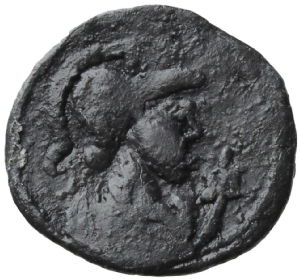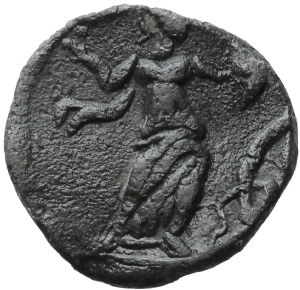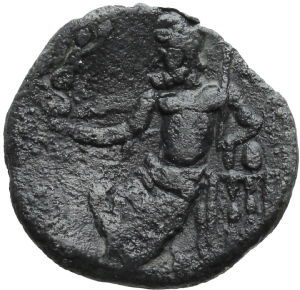All entries for Monday 17 August 2020
August 17, 2020
Lead Tokens depicting Athena from Roman Oxyrhynchus
The result of our excavations showed that I had been so far right in that the rubbish mounds were nothing but rubbish mounds; and the miscellaneous small anticas which we found are of little interest…
Grenfell 1896-1897, 3.
Oxyrhynchus, the ‘city of the sharp-nosed fish’, is situated in the Fayum of Egypt. Originally an Egyptian city that was colonised by the Greeks, it continued to thrive under the Romans. Today is best known for the reams of Ptolemaic and Roman papyri discovered in its rubbish heaps by Grenfell and Hunt in the late nineteenth and early twentieth centuries. There is, however, more to Oxyrhynchus than its papyri, and after more than a hundred years some of the so-called ‘miscellaneous small anticas’ deserve reassessment.
Amongst the artefacts of which Grenfell was so disparaging, are around three hundred lead tokens, dating to the Roman period (Milne 1922, 159). These small, unassuming objects, often worn and with traces of their designs barely discernible, are largely ignored in modern scholarship. A series of papers published in the early 20th century by J. G. Milne focused on identifying the types, and posited that they functioned as a low-denomination token coinage. How tokens were used in Roman Egypt still remains uncertain, but analysis of their iconography can move beyond identification of types.
Milne rightly noted that different series of tokens were present at Oxyrhynchus (Milne 1908, 297). Some have imagery similar to the Alexandrian coinage, depicting for instance deities such as Serapis or Nilus. Like Alexandrian coins, tokens often have a date in regnal years which is signified by an ‘L’ before the numerals in Greek. Unlike coins, tokens in Roman Egypt don’t bear the portrait of the emperor, and so it is usually unclear to whose reign this date refers. Tokens of this series are found on other sites in Egypt, such as Antinoopolis, Karanis and elsewhere in the Fayum, as well as just outside of Egypt at Qasr Ibrim and in a shipwreck off Israel’s Carmel coast.
In contrast, another series of tokens appears to have local significance to Oxyrhynchus. These all feature the goddess Athena on one face. Most frequently it is her bust that is depicted (Figure 1) but she also appears fighting a serpent (Figure 2), and sometimes her cult statue features within a temple. Most tokens pair her with Nike on the reverse, aside from a small subset on which Zeus is depicted seated (Figure 2).
 |
 |
Figure 1: Token depicting Athena with labrys. Obverse: Bust of Athena-Thoeris right, wearing Corinthian helmet, labrys to front. Solid line border. Reverse: Nike advancing left, holding wreath in right hand and palm in left hand; ΟΞ. Solid line border. Metal: Lead. Diameter: 20mm. Weight: 3.34g. Die axis: 11. Ashmolean Museum, Milne 5302. Image: Ashmolean Museum.
Despite the variation in the manner of her depiction, there is clearly a preference for tokens featuring Athena at Oxyrhynchus; Milne identified the goddess on 184 tokens out of a total of 271. This frequency is further emphasised by the fact that the Oxyrhynchite Athena types are not found anywhere else in Egypt (Milne 1908, 297. This still holds true based on the data available today, which includes discoveries made after Milne’s study.). The presence of the Greek legend ‘ΟΞ’ (OX) on some of the Athena tokens also clearly refers to the first two letters of Oxyrhynchus. This legend works alongside the imagery to emphasise the distinct local character of this type of token.
The uniqueness of these tokens to Oxyrhynchus is further exemplified by the choice of attribute for Athena on the tokens: the labrys, or double-headed axe. It is present on types where she is depicted attacking a serpent and also alongside her bust. The labrys is an unusual attribute for Athena. It does not feature alongside her on many depictions from antiquity, aside from one representation from Mycenae, the nome coinage of Οxyrhynchus, possibly on a terracotta lamp from Οxyrhynchus, and perhaps as part of a statue of Athena found at Οxyrhynchus (LIMC II, Athena no. 2; LIMC II, Athena no. 27; RPC III 6355-6358; British Museum OA.11020;Mathiopoulos 2001, 202-217 for the statue, who posists that the statue’s missing attribute is a cornucopia. However, a labrys is also a possibility, given the association of Athena with this attribute at Oxrhynchus).
 |
 |
Figure 2: Token depicting Athena fighting serpent. Obverse: Athena-Thoeris advancing right, holding labrys in right hand and shield in left, attacking serpent before her. Reverse: Zeus seated left, in right hand holding Nike right with wreath, and in left hand holding sceptre. Metal: Lead. Diameter: 23mm. Weight: 7.88g. Die axis: 11. Ashmolean Museum, Milne 5304. Image: Ashmolean Museum.
In terms of the significance of the labrys to the town, current scholarship does not appear to have reached a definitive conclusion. In her study of the double-headed axe, Kouremenos states in reference to the nome coinage of Οxyrhynchus that it might be associated with workmen in the city that used the double axe as a woodworking tool (Kouremenos 2016, 47). Others have interpreted the presence of the labrys on the nome coinage as an ‘Egyptian’ emblem, due to the fact that in art it was often depicted with the Egyptian god Tutu, in which context it has been interpreted as an apotropaic symbol (Weber and Geissen 2013, 168). Its association with Athena at Οxyrhynchus might be viewed as acknowledging her role as a protective guardian goddess of the town, while also amalgamating Egyptian and Greek elements (Weber and Geissen 2013, 168). The labrys is, however, found frequently in Greek and Roman art (Kouremenos 2016, 43-50 for overview). In this regard, it appears in many places in different contexts, similar to the manner in which the imagery of Athena is common. It is, however, only when Athena and the labrys appear together in the specific context of the material culture of Οxyrhynchus that they are able to transform into a new image which becomes associated with the locality.
 |
Figure 3: Coin of Hadrian (nome coinage). Obverse: laureate bust of Hadrian, right; border of dots; ΑΥΤ ΚΑΙ ΤΡΑΙ ΑΔΡΙΑ CΕΒ. Reverse: Athena standing facing, head left, wearing Corinthian helmet, holding labrys in left hand and Nike in extended right hand; border of dots; ΟΞΥΡ/ LΙΑ. Metal: Bronze. Weight: 4.70g. Mint: Alexandria. Date: AD 117-138. RPC III 6357. Ashmolean Museum Accession no. HCR34309. Image: Ashmolean Museum.
The unusual pairing of Athena with the labrys at Οxyrhynchus was not her sole distinction from the ubiquitous Athena of the classical world. From numerous references in the town’s papyri, it is evident that Athena was equated with, or given the epithet of, the goddess Thoeris. There are references to ‘worshippers of the cult of Athena-Thoeris’, the ‘temple of Athena-Thoeris’ and the ‘place of the temple of Athena-Thoeris’, amongst others (P.Oxy. 3.579; P.Rein. 2.93; P.Oxy. 34.2722; P.Oxy. 50.3567). To some extent perhaps the goddesses were perceived as separate: one document refers to ‘the temple of Athena and Thoeris’ (P.Oxy. 10.1268).
Thoeris is the Greek name for the Egyptian goddess Taweret. She took the form of a hippopotamus, and her worship had become prominent at Οxyrhynchus from the late Ptolemaic period (Whitehorne 1995, 3080-82). The reason for the connection of Athena to Thoeris/Taweret in not clear, but it is perhaps because each goddess was associated with childbirth and fertility (Whitehorne 1995, 3080-82). In ancient Egypt Taweret was associated with the protection of women and children. Inscribed magical knives from the Middle Kingdom period bear apotropaic figures and texts indicating that they were for the protection of women and children, and most frequently feature Taweret as the apotropaic figure (Weingarten 1991, 4: 45 out of the 58 published knives feature Taweret). From the New Kingdom, jugs in the form of Taweret were used for the pouring of libations from a hole in one of the jug’s breasts, indicating an association with childbirth and breastfeeding mothers (Bruyère 1939, 104-107). Athena’s link to women and motherhood is less explicit, but it is perhaps her capacity as a protector that syncretises her with Taweret.
 |
Figure 4: A faience amulet depicting the Egyptian goddess Taweret. 332-30 BC. The Metropolitan Museum of Art, accession no. 26.7.888. Creative Commons CC0 1.0 Universal Public Domain Dedication.
Despite the outwardly classical style of Athena on these tokens, these syncretisms should be taken into account. The Athena depicted on these tokens’ had associations with Thoeris, and her Egyptian counterpart Taweret, which lent a particular local context to the way in which the imagery may have been viewed and read by the community of Οxyrhynchus. Veronique Dasen has also reached similar conclusions in her analysis of a gem depicting Athena attacking a serpent with a labrys, which bears the inscription ‘Thoeris’ (Dasen 2019). She considers how the imagery of the gem could have been read on both Greek and Egyptian terms due to the iconography evoking all three goddesses.
The choice to depict Athena in classical form underlines the creation of tokens in a Graeco-Roman milieu, especially as Taweret was concurrently worshipped independently at local shrines and certain populations would have recognised her Egyptian guise. This does not, however, discount the possibility that those who used and viewed tokens interpreted the image on their own terms and read different combinations of Athena, Thoeris and Taweret.
Blog written by Denise Wilding, The University of Warwick.
The content of this blog is adapted from: Wilding, D. 2020. Tokens and Communities in the Roman Provinces: An Exploration of Egypt, Gaul and Britain. Unpublished PhD thesis, The University of Warwick. With thanks to the Humanities Research Fund, University of Warwick for their support.
Bibliography
Bruyère, B. 1939. Rapport Sur Les Fouilles de Deir-El-Médineh, 1934-35. Cairo: l’Institut Français d’Archéologie Orientale.
Dasen, V. 2019. “One God May Hide Another. Magical Gems in a Cross-Cultural Context.” In Magical Gems in Their Context, Proceedings of the International Workshop Held at the Museum of Fine Arts, Budapest 16–18 February 2012, edited by K. Endreffy, Á.M. Nagy, and J. Spier, 47–58. Rome: L’Erma Di Bretschneider.
Grenfell, B. P. 1896-1897. “Oxyrhynchus and Its Papyri.” Archaeological Report (Egypt Exploration Fund) 1896-1897: 1–12.
Kouremenos, A. 2016. “The Double Axe (Λάβρυς) in Roman Crete and beyond: The Iconography of a Multi-Faceted Symbol.” In Roman Crete: New Perspectives, edited by J. E. Francis and A. Kouremenos, 43–58. Oxford: Oxbow Books.
Mathiopoulos, E. 2001. “On the Transformation of the Athena Velletri Type in Hellenistic Alexandria.” In Athena in the Classical World, edited by S Deacy and A. Villing, 197–218. Leiden: Brill.
Milne, J. G. 1908. “The Leaden Token Coinage of Egypt under the Romans.” The Numismatic Chronicle and Journal of the Royal Numismatic Society 8: 287–310.
Milne, J. G. 1922. “The Coins from Oxyrhynchus.” The Journal of Egyptian Archaeology 8: 158–63.
Weber, M., and A. Geissen. 2013. Die Alexandrinischen Gaumünzen Der Römischen Kaiserzeit. Die Ägyptischen Gaue Und Ihre Ortsgötter Im Spiegel Der Numismatischen Quellen. Wiesbaden: Otto Harrassowitz.
Weingarten, J. 1991. The Transformation of the Egyptian Taweret into the Minoan Genius: A Study in Cultural Transmission in the Bronze Age. Partille: Aström Forlag.
Whitehorne, J. 1995. “The Pagan Cults of Roman Oxyrhynchus.” Aufsteig Und Neidergang Der Romischen Welt II (18.5): 3050–91.
 Clare Rowan
Clare Rowan

 Please wait - comments are loading
Please wait - comments are loading

 Loading…
Loading…